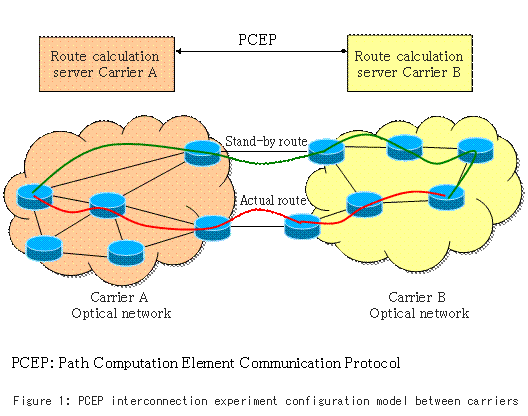- October 17, 2008 Succeeded in PCEP interconnection experiment
-
Succeeded in interoperability route calculation servers in optical networks provided by multiple carriers
Significant progress in building a large-scale, reliable optical networkBefore the rest of the world, the Interoperability Working Group at Research Promotion Council of the Keihanna Info-Communication Open Laboratory (hereinafter called “Interoperability WG”, WG Chair: Professor Naoaki Yamanaka at Keio University) succeeded in the experiment of interconnecting PCEP (Path Computation Element Communication Protocol), a protocol to help find an efficient communication network route in the interconnection between future optical network carriers (telecom carriers) by utilizing the Keihanna Info-Communication Open Laboratory owned by the National Institute of Information and Communications Technology (hereinafter called NICT, President: Dr. Hideo Miyahara).
PCEP is a protocol being promoted as an international standard by IETF (Internet Engineering Task Force). In order to varify the effectiveness, the Interoperability WG has been engaged in the project of the interoperability experiment between multiple carriers using PCEP, in collaboration with KDDI R&D Laboratories (hereinafter called “KDDI Lab”), NEC Corporation (hereinafter called “NEC”) and Hitachi, Ltd. (hereinafter called Hitachi).
In this experiment, we verified the procedures to calculate multiple communication network routes without disclosing the carriers’ internal network configurations. The result is to prove that the basic technology to calculate a reliable route across multiple carriers has been verified, which was a significant stride toward building a large optical network in the future.Background
● With the growth of the Internet, it becomes indispensable for networks today to be interconnected on a worldwide scale. In addition, with the rapid spread of broadband internet communications, the traffic continues to increase. In order to respond to it, the capacity of the network using optical technology needs to grow more. It means that the technology is required that interconnects the optical networks provided by different carriers (telecom carriers) worldwide.
● To realize this, a technology was needed that could calculate the appropriate route across multiple carriers. For an optical network, which is different from a best effort type of network like the Internet, a connection called an optical path must be preconfigured in line with the route that allows securing the required network resources. In a large network that consists of multiple interconnecting carriers, it is difficult to centrally understand the entire configuration. Therefore, the issue was to calculate a route across all networks.
● From a security perspective, it was required to calculate a route across multiple carriers without disclosing their internal network configurations. Moreover, to improve network reliability, it is necessary to calculate a stand-by route that does not overlap from end to end with the actual route in use. To achieve this, we had to understand where the actual route goes across multiple carriers. It was difficult to calculate a route without disclosing carriers’ internal network configurations.
Results
●To resolve the above issue, we located a route calculation server at each carrier and had the servers communicate with one another using the route calculation protocol, PCEP (Path Computation Element Communication Protocol). This will allow calculating a route dispersively across multiple carriers.
●Also, tag information called Path Key allows the calculation of a route across multiple carriers without disclosing carriers’ internal network configurations. In addition, using Path Key as an exclude condition in a route calculation allows calculating multiple routes not overlapping one another from end to end across multiple carriers without disclosing their internal network configurations.
In this experiment, we were successful first in the world in calculating routes dispersively via PCEP’s interconnection in the network model described in the figure 1 as considering interconnection of optical networks provided by different carriers. The major results are as follows:
- (1) In order to calculate a route across optical networks provided from multiple carriers, we succeeded in the interoperability experiment of a communication using PCEP that is used between the route calculation servers.
- (2) In the calculation a route across optical networks provided from multiple carriers, we succeeded in calculating a route without disclosing the carriers’ internal network configurations.
- (3) Succeeded in calculating the actual route and standby route that do not overlap each other across the optical networks provided by different multiple carriers.
(Interoperability WG provided an opportunity for discussion on interconnection validation and advertised the technical information with aid of carriers and vendors prior to the full-scale introduction of the optical network into carrier’s network)

Perspectives
Based on the success of this interconnection experiment, we will promote the improvement of the interoperability in cooperation with overseas companies and consortiums. We also would like to report the experiment results to organizations like IETF, which is promoting standardization of PCEP, and contribute to successfully creating an international standard. Thus, Interoperability WG will be promoting research and development to establish the interoperability of optical networks across different carriers and to create a first international standard published by Japan.
Supplement

- Path Computation Element Communication Protocol, which is a communication protocol to request and respond to calculate routes between route calculation servers. IETF (Internet Engineering Task Force) is currently working on its international standardization.

- KDDI R&D Laboratories Inc.
NEC Corporation
Nippon Telegraph and Telephone Corporation
Hitachi, Ltd.
Based on the following protocol specifications
“Extensions to the Path Computation Element Communication Protocol (PCEP) for Route Exclusions,” IETF Internet Draft, Work in Progress
(Press released on October 17, 2008)

